
|   |

|   |
Dance Jathre 2022: India's unique dance fair - Ashwini Naik e-mail: ashwini.naik.gad@gmail.com Photos: Padmanabh May 6, 2022 Jathre in Kannada means a fair, a celebration. A gathering of people to celebrate an event, an occasion to come together. Dance Jathre is exactly this, a celebration of dance, a coming together of people to experience, learn, share their art. Dance Jathre is a brainchild of Guru Vyjayanthi Kashi. She has been ably supported by her daughter-disciple Prateeksha Kashi and the students of Shambhavi School of Dance. Dance Jathre was back this year in its very special 10th edition, at Shankara Foundation, Bangalore on April 9th and 10th. An amalgamation of competitions, workshops and performances, it has been successfully running with active participation by artistes, dance enthusiasts, students, parents alike. Dance Jathre has never differentiated between dance forms. This is one stage where folk meets classical meets modern dance forms. This has been a platform for the young generation to meet their idols, learn from them and observe them dance, picking up the nuances. As should be the norm in a fair, Dance Jathre also has its share of little stalls selling books related to dance, jewellery, dance practice sarees and other related items. Beautiful decorations, many of them made using the picture memories of earlier jathres adorned the venue. Due to the pandemic, Dance Jathre also went hybrid this year. Yes, Dance Jathre competitions were partially done online, as well as the workshops were available for online as well as offline participation. The solo competitions for junior, sub-junior and senior categories were handled with online competitions prior to the event days. Only the duets and group competitions went offline. 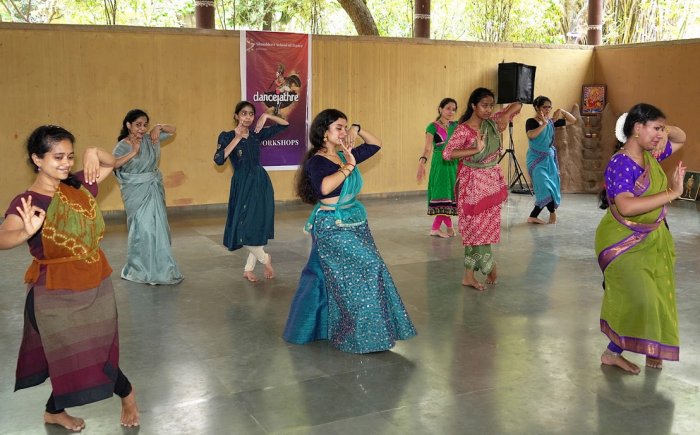 Workshop by Vempati Balatripura Sundari The jathre kicked off to a great start on 9th April morning with inauguration by Vyjayanthi Kashi and Chavali Vempati Balatripura Sundari. The inauguration was marked by a beautiful rendition on Nataraja by Akshatha. Fellow dancers including Sandhya Udupa, Vandana Kasaravalli, Prateeksha Kashi and Gururaju were also a part of the inauguration. The jathre kicked off soon after with not just the senior group and duet competitions, but also with a workshop by Chavali Vempati Balatripura Sundari. The impact of the pandemic on the art front was visible, with the number of competitors in groups and duets reducing than earlier years. Missing months of offline group practice sessions when the pandemic raged was cited as a reason. Those who still managed to be a part of the competitions left a very strong impression on the audience and judges alike. The ashtapadi workshop conducted by Balatripura Sundari was very sought after by online and offline participants. It was a great opportunity for all to learn Jayadeva's ashtapadi Radhika-Krishna, choreographed by Guru Dr. Vempati Chinna Satyam, directly from his daughter. Bala has learnt Kuchipudi and this dance purely by watching her father perform and teach. The ashtapadi talks of the emotional pain Radha is going through when Krishna refuses to meet her or interact with her. Her emotional pain also reflects on her physically, and explaining her pain to her sakhi, she expresses that even the jewellery she is wearing is becoming heavy and a burden. The sandalwood paste and the perfume that her sakhi prepares for her also feel like poison to Radha. The sakhi takes it upon herself to convince Krishna to come and meet Radha and not make her suffer. She explains to Krishna, how Radha has grown physically weak and her countenance is like a half-moon. Radha continues to suffer the separation from Krishna, as he continues to stay away from her and with other gopikas. The nuances of this Ashtapadi were beautifully brought out in the choreography. The pain of Radha, the eagerness of her sakhi to help her, the distance of Krishna and his frolics with other gopikas were explained brilliantly to ensure the participants were able to ingest the abhinaya concepts well. Considering that 3 hours are very short to learn an ashtapadi, the successful outcome of the workshop was still visible in the participants' performances. Bala ensured she explained not just the sequence or abhinaya, but also the little nuances, the subtlety needed to express the emotions better. And these little, but profound learnings of abhinaya and movements are what would stay with the participants forever. 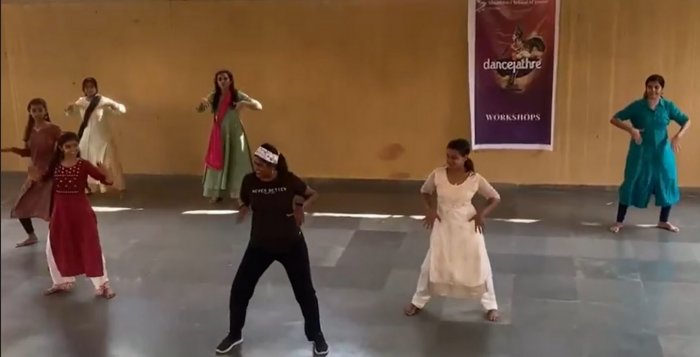 AfroFit by Cynthia Rajan The afternoon commenced with a workshop on AfroFit by Cynthia Rajan. AfroFit is a full-body, high-intensity cardio workout and dance in Afrobeats. Cynthia is a teacher by profession and a dancer by passion who has been in the field of dance and fitness for 6 years now. She was trained by Jothi Viknesh, master trainer for Afro works. The participants had the chance to swing to African music in this invigorating and fun workshop. The energy levels of the trainer and the participants were to be seen to be believed. Cynthia ensured that the participants of Bangalore could also swing to Kannada songs, helping them connect closely to known music while also learning the moves for further workouts. 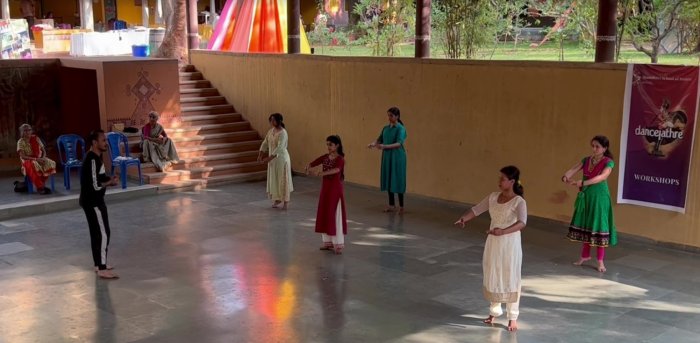 Contemporary workshop by Suraj L The final workshop of the day was based on Contemporary dance, conducted by Suraj L. The workshop titled "Find your flow" was aimed at teaching the participants to develop more fluidity in their movements and build up and use their energy towards the same. Suraj is a contemporary, jazz, hip-hop, classical ballet dancer. He has trained with Terence Lewis Contemporary Dance Company, Mumbai. He started the workshop with simple movements, helping the participants to strengthen their breathing and build energy in the body. He slowly moved towards complex movements that helped them to stretch and start moving in a fluid manner, gradually increasing the speed and the variety in floor movements while still being able to control the body, testing the participants' fluidity, flexibility and movement quality. 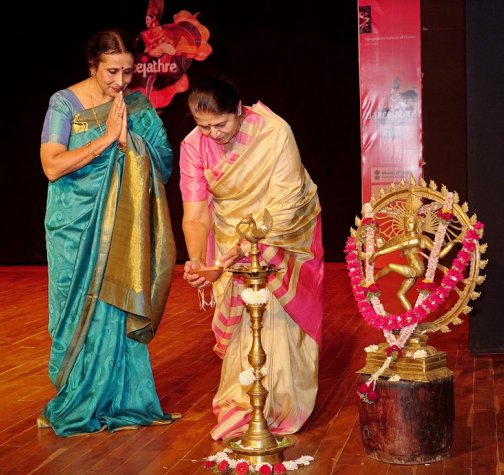 Vyjayanthi Kashi & Dr. Choodamani Nandagopal The first evening saw some mesmerizing performances by eminent Gurus and their students. Vyjayanthi Kashi began the evening event reminiscing the journey of Dance Jathre, the vision behind it and how other festivals like Chitra Santhe inspired her to start this annual event. She welcomed the chief guest Dr. Choodamani Nandagopal, an eminent art historian and Tagore National Fellow, who also inaugurated the evening event. Her book 'Dance and Music in Temple Architecture', 'Classical Dance Heritage of Karnataka' and others are in high demand. She is also a trained Bharatanatyam, Kathak and Kuchipudi dancer. She has dedicated her life to Indian art and cultural heritage. 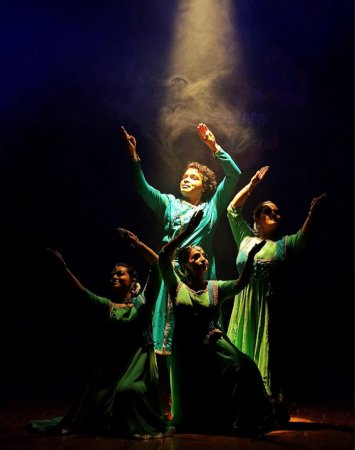 Hari and Chethana with Noopur ensemble The first performance of the evening was titled Sambhram, a Kathak celebration by the celebrated couple Hari and Chethana and their students of Noopur Performing Arts Center. Their first presentation was titled Bhavana which started with the shloka Kasturi thilakam written by Vallabhacharya, describing Krishna, followed by the presentation of Nrithya aspect of Kathak including laditihai, tatkar, tukda, and others, set to raag Sohni and teen taal. The second presentation was a Jugalbandi, a dialog pattern between the percussionist and the dancer's footwork, followed by a Sargam on raag Malhar. If the first two recitals focused on intricate, fast-paced footwork and chakkars, the final recital was an abhinaya item, Madhura Madhav, written by Swati Thirunal depicting the Madhura bhakti between Radha-Krishna, set to raag Brindavani Sarang. The couple left a mark on the audience with their beautiful presentation. 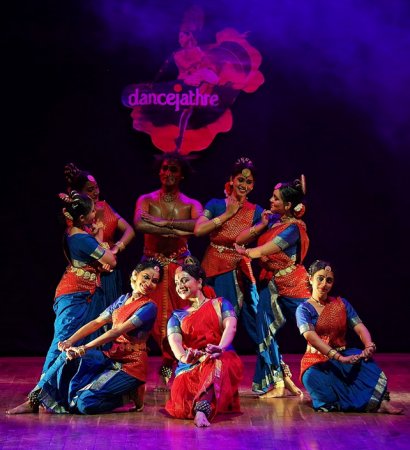 Shambhavi Dance Ensemble This was followed by a highly energy packed Kuchipudi performance titled 'Shanthipath' by Shambhavi Dance Ensemble, with concept and choreography by Guru Vyjayanthi Kashi. This production created specially for the 75th year of Indian independence, paid tributes to the contribution of our martyrs to the freedom struggle. One must strive for purposeful actions which will benefit future generations with inspiration, guidance and values. With this vision in mind, Shantipath was created to showcase the contribution of the rulers of Karnataka to the struggle. It speaks of the first women freedom fighter of India, Rani Abbakka of Ullal, who kept the Portuguese at bay for 4 decades. She even gained the name Rani Abhaya, the fearless. Her fight was an inspiration to the future struggles of Tipu Sultan, Dhondiya and even Kittur Rani Chennamma against the British. The composition continues to provide rich tribute to Rani Chennamma, the queen of Kittur, whose courage was indomitable. The composition had its script penned by late Dr. Saashi Marulayya, and goosebump inducing music composed by late Jhanavi Jayprakash. The warrior-queen's entry is always a very exciting piece in Vyjayanthi Kashi's compositions, and very well executed by Prateeksha Kashi. The troupe very beautifully showcased the valour of the warriors with the war sequences while also gracefully showcasing the sequences describing the kingdoms. Later, awards were given away to the winners of the solo categories of dance that were conducted online in February by the chief guest, Dr. Choodamani Nandagopal. Addressing the gathered audience, she spoke of the importance of our dance forms in our Indian culture.The uniqueness of our culture is that it includes not just classical forms, but also the numerous folk art. As an art historian, she emphasized that Indian sculpture, dance, music, iconography, temple architecture, are all connected, and together they represent our real culture. Dance in her view, is a prayer and a life-long journey that has no end. She appreciated the dynamism and innovative ways that Vyjayanthi Kashi has attempted to bring the dance forms together and keep them alive. Just as Chithra Santhe that Dr. Choodamani and her colleagues started together has now become a national phenomenon, bringing multiple people together sharing their art, the same way she sees that Dance Jathre is also turning into a phenomenon across.  Sanjay Shantaram and Shivapriya Dance Ensemble The final performance of the evening was by Dr. Sanjay Shantaram and his Shivapriya Dance Ensemble. Sanjay is a dancer, choreographer, actor and vocalist. A trained Bharatanatyam and Kuchipudi dancer, Sanjay with his students together, performed 2 pieces, which he had himself penned and tuned the songs for. The first piece was on Lord Rama, "Rama Rama yendu bhajiso nee mana", which spoke of the mukti or salvation attained by his devotees by just taking the Lord's name. In this composition, Sanjay very beautifully brought out the bhakti of Shabari and Guha, and the devotion of Jatayu who even gave his life for Rama. They all attained mukti, including Ravana, his arch enemy, on being killed by him. Sanjay's portrayal of Shabari and Ravana was a treat to watch. He was very ably and beautifully supported by the wonderful performances of his disciples. This piece composed in Yaman Kalyani raga and adi tala, was sung by Raghuram and re-tuned by Praveen D Rao. The second piece was a beautiful presentation on Lord Krishna, "Aadiyu neene, Anthyavu neene". The piece speaks of how Krishna didn't differentiate between rich or poor, be it his friendship with Sudhama, or when he lifts Govardhanagiri to help all his devotees. Krishna is the one who destroys all evils, is the beloved of all rishis and all the gopikas. He also is Shiva Priya or Shiva's favourite. The composition in raga Hamsanandhi and adi tala was again sung by Raghuram and re-tuned by Praveen D Rao. 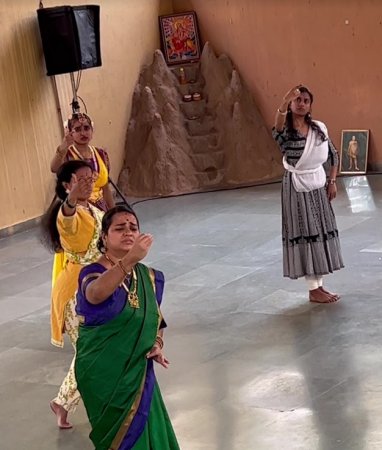 Workshop by Dwaritha Vishwanatha The second day began with very active participation for Duet-Junior categories competitions. A steady stream of enthusiastic little dancers was flowing in, all eager to participate and share their talent. The day also saw a first workshop on Javali being presented by Dr. Dwaritha Vishwanatha. Dwaritha has completed her diploma course in Bharatanatyam, is also a Masters in Sanskrit and has received PhD for her thesis on the Ashtavidha Nayikas and their exposition in dance forms. Dwaritha started the workshop initiating the participants, both online and offline, to the concepts of Ashtanayika. Explaining the concepts with very simple, today's examples, she got the participants to settle into the mood of the Nayika. The Nayika she chose for the workshop was Avasitapravaasapatikaa, a combination of Prositapatika and Svadhinapatika. She used a beautiful Kannada composition "Bandeya sundaranga bandeya" written by Dr. Shatavadhaani R Ganesh, with music composed and sung by Balasubrahmanya Sharma. The music was set in raga Jinjuti and tala tishragati adi. The dance was choreographed by her. The Javali speaks of a Nayika whose Nayaka has come back home after a long time. As much as she is excited, she is also overcome by multiple emotions remembering her separation and longing for her Nayaka. She is equally jealous of the other women who are surrounding her. She continues to explain to her nayaka how she always missed him, and she drooped like a lotus in the night. But now, she feels joyous and is blooming like a lotus in sunlight. She wants to know if her nayaka also had missed her as much, and happily sighs when he says he did. She enquires on his journey and business, and now wants him to stay with her forever. Dwaritha used Uddipana Vibhava like waxing and waning of the moon for indicating the months passing away, and using anubhavas like sigh, sorrow, and effectively incorporating bhavas like Romancha, Asru, Smriti to depict the varied emotions and reactions of the nayika. It was a little difficult to decide, whether the huge smile we had on our faces was watching the effortless abhinaya of Dwaritha or the simplicity and ease with which she taught the students to express the Javali. 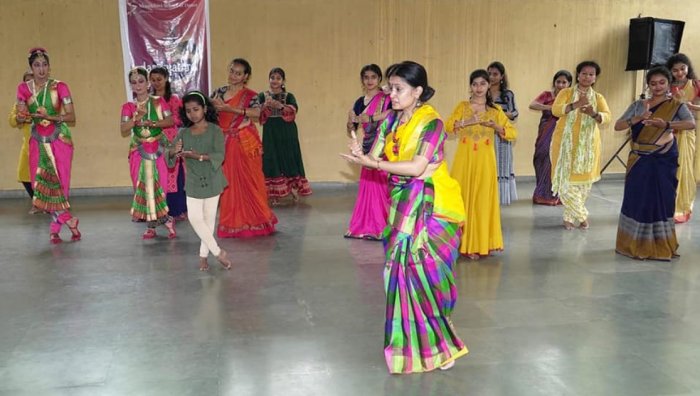 Workshop by Kausalya Nivas Post this workshop there was an impromptu Bharatanatyam workshop which Kausalya Nivas was kind enough to conduct. It being Ramanavami, and having Kausalya who has dealt with the subject of Hanuman extensively, it was a pleasure to have her teaching Hanuman Chaalisaa to a bunch of enthusiastic learners. Her depth of the subject, and the quick learning method she applied was well appreciated. She was successful in bringing out a range of emotions, and especially bhakti bhava in the students on this auspicious day. 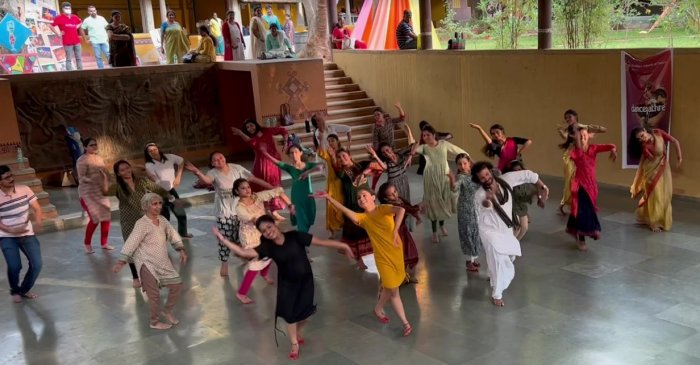 Workshop by Devesh Mirchandani The second half of the day was covered by a Garba and semi-classical workshop by the very young and talented Devesh Mirchandani. He is a trained Kathak dancer and a student Pt.Birju Maharaj, who has also turned into a household name for his choreographies in Hindi films. The very energetic workshop was focused on teaching the nuances of Garba, followed by his choreography on the popular song Dholida from the movie, Gangubai Kathiawadi. He started the workshop with simple basics of Garba, slowly increasing the complexity and bringing it together into the choreography of Dholida. The choreography also borrowed from Kathak making it a beautiful experience. The biggest challenge of the evening was to keep the participants from colliding into each other while performing the famous six-step garba, which on the other hand, Devesh effortlessly and gracefully performed moving all across the floor. But it was quite surprising to see the energy levels of the participants still staying very high in spite of the 3 continuous hours of high-intensity dancing. 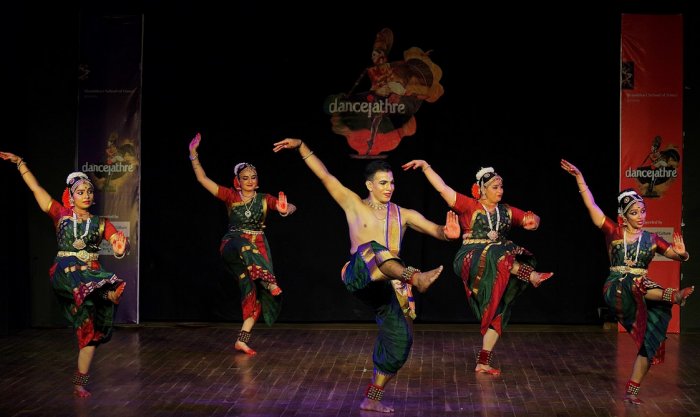 Students of Reva University The Dance Jathre concluded with more performances in the evening, meant to stimulate the audience with rasanubhava. The performances began with the winners of the Senior Group dances performing their winning numbers on stage. The winners of the senior group and the duet competitions were also awarded the prizes. This was followed by a high-energy Kuchipudi Tarangam by the students of Reva University on the very popular Oothukadu Venkata Subba Iyer kruti, Marakata manimaya chela, describing the glory and splendour of Lord Krishna.The group performed well on the fast-paced tarangam, showcasing their dance skills on the traditional brass plate. 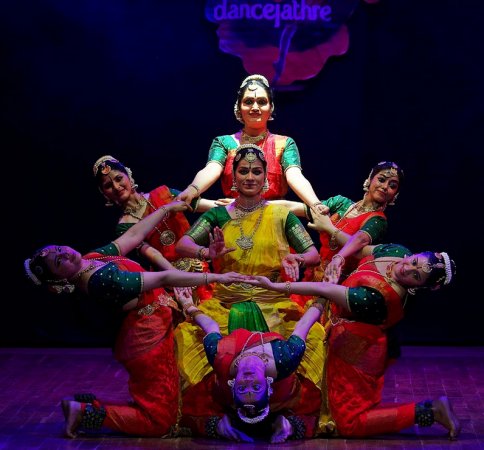 Anuradha Vikranth & Drishti Dance Ensemble Anuradha Vikranth was next on stage with her Bharatnatyam performance titled Navarasa Shakti, the power of nine emotions of Goddess Durga. She was ably joined by her Drishti Dance Ensemble on stage. Anuradha is a renowned dancer who has been blending tradition with innovation, generating creative choreographies and is the creator of the Dhristi National Dance festival. The choreography she presented had lyrics written by ShatavadhaniDr. R Ganesh, with music composition by D S Srivatsa and Gurumurthy. In this composition, Anuradha brought out the nine rasas very beautifully relating them with seven different stories from the life of Devi. Her command on the rasas, and the troupe's splendid coordination and portrayal of the stories left the audience spellbound. Shringara, with maiden Parvati falling in love with Shiva at first sight. Veera, with goddess Durga and her tiger killing the demon brothers Shumbha and Nishumbha. Karuna, with the story of Dakhshaini who overcomes her humiliation for her sakhis. Hasya, as seen by Parvati devi in her sons' interaction and pranks. Bheebatsa, the gruesomeness with which Kali slays Raktabija and consumes his blood. Raudra, with the angry Goddess Durga killing Mahishasura. Bhayanaka, her fear when lord Shiva opens his third eye and kills Manmatha. Adbhuta to see the Goddess as one who herself is a manifestation of the trimurti. Shanta, her being at peace when she has ensured her devotees are at peace. 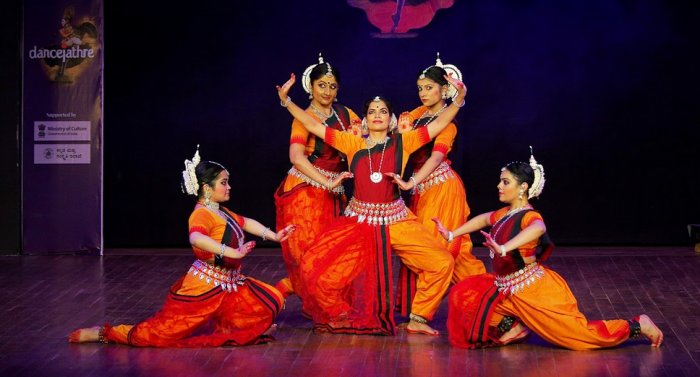 Madhulita Mohapatra & Nrityantar Ensemble The evening closed with performances by Madhulita Mohapatra along with her dancers from Nrityantar Dance Ensemble. The troupe started their performance with Shivam Dhimahi, a dance offering tribute to the Lord of dance, Nataraja, choreographed by Madhulita to script by Pandit Nityananda Mishra, rhythm composition by Guru Dhaneswar Swain and music by Sukanta Kundu. This was followed by the traditional graceful Odissi piece Pallavi, set to Raag Janasammohini and taal ektaali. Again, the choreography was by Madhulita, to music set by Bijaya Kumar Jena, and rhythm composition by Bijaya Kumar Barik. They ended the repertoire with Hari smarane maado in praise of Lord Vishnu which is a popular devaranama by Purandara Dasa. The choreography by Madhulita incorporated popular stories where devotees have sought shelter under the protection of the lord, like the story of the elephant saved from crocodile, story of Prahlada where the lord saved him multiple times from the atrocities of Hiranyakashipu like burning in fire, being trampled by elephants, and finally slayed Hiranyakashipu in the form of Narasimha.The music was composed by Bijay Kumar Jena and rhythm composition was by Bijaya Kumar Barik. It was a real treat to see the teacher and the students being equal participants in the dances, and this needs to be attributed to the command the students had on the dance form which has come from their training. Odissi dancer from Bangalore, Anjali Raj Urs hosted the evening events of both the days. Vyjayanthi Kashi and Prateeksha Kashi wrapped the 10th edition of Dance Jathre thanking all the volunteer students and parents and providers of supporting accessories like light, sound, camera, who helped make this edition a success like every year. Though the participation was relatively lower, we all hope that the dark clouds covering the art scene would soon start dissipating and we soon will see huge crowds back again at the next editions. Dance Jathre is bound to bounce back with more interesting events soon. 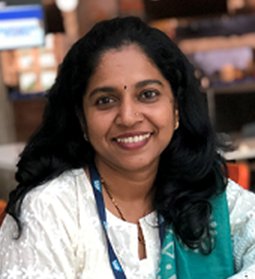 Ashwini Naik is a corporate leader, dance enthusiast and an amateur writer. Vice President in a multinational, Ashwini tries to intertwine her vocation and avocation by driving cultural initiatives in the corporate world. Having trained in Bharatanatyam and Kuchipudi, Ashwini shares her learnings in dance and language with her corporate friends. |